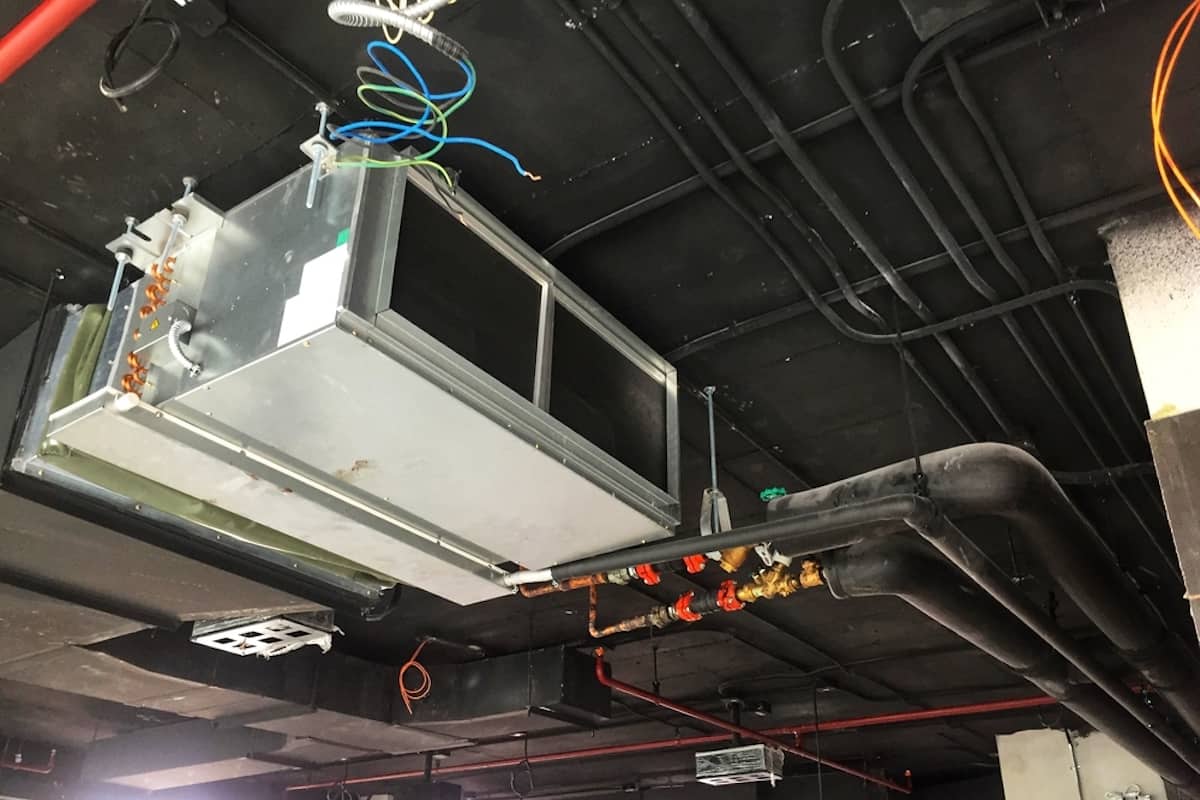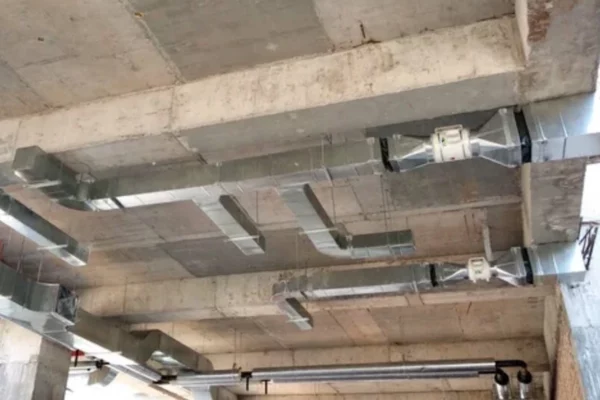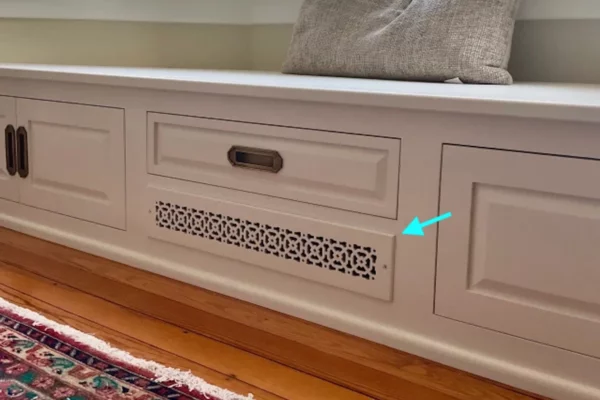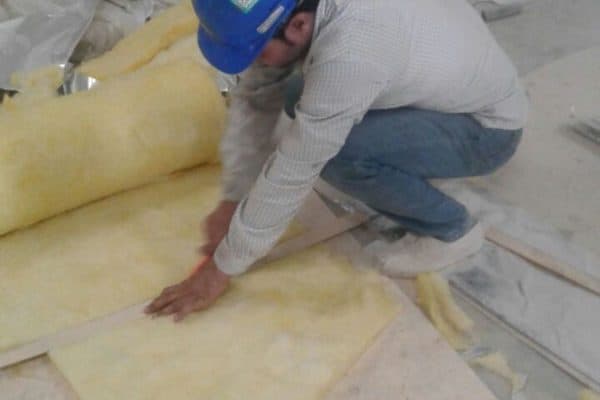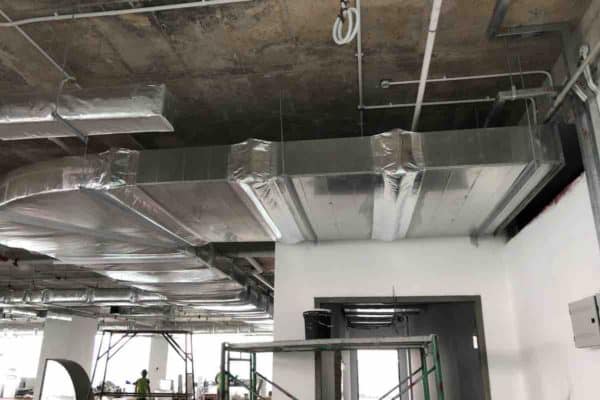What is a Plenum Box? (Purpose on FCUs and Diffusers)
A plenum box is a common and essential component in HVAC. However, not many people realize the true function of a plenum box. So, what exactly is a plenum box and what is the purpose of a plenum box?
A plenum box is usually a galvanized iron box installed before the cooling coil of a fan coil unit to reduce the velocity of the return air such that the face velocity of the cooling coil is not more than 2.5 m/s. Besides, a plenum box also serves the purpose to mix the fresh air with the return air.
Many people think that a plenum box is used to mix the fresh air with the return air. However, they don’t realize that a plenum box actually serves a more important purpose.
What is the Purpose of a Plenum Box?
A plenum box can be found at the back of a fan coil unit (FCU) or an air handling unit (FCU). Besides, it also can be found at the back of a supply air diffuser or an external air louvre.
Plenum Box at the Back of FCUs and AHUs
The main purpose of having a plenum box installed at the back of a fan coil unit (FCU) or an air handling unit (AHU) is to reduce the velocity of the return air such that the face velocity of the cooling coil does not exceed 2.5 m/s.
Face velocity is the off coil air velocity. It is the velocity of the air right after the cooling coil of a fan coil unit (FCU) or an air handling unit (AHU).
During the selection of FCUs and AHUs, manufacturers always fix the face velocity at below 2.5 m/s (slightly above 2.5 m/s is fine). The reason why the face velocity must be fixed at below 2.5 m/s is that when the face velocity exceeds 2.5 m/s, condensate water on the surface of the cooling coil will be blown away (detached from the surface) and thus, not drip on the condensate drain pan and cause water leakages and other associated problems such as mold and fungus growth.
In other words, if the air velocity is more than 2.5 m/s, it is considered too strong and the condensate water on the surface of the cooling coil will “fly out” and not drip on the drain pan properly.
Usually, ducts are sized based on friction loss. Engineers fix the friction loss at 0.1 in.WG per 100 ft to calculate the required duct size at a given airflow rate regardless of the air velocity.
However, when it comes to the cooling coil, air velocity must be controlled and thus, a much larger duct called a plenum box is used to increase the internal volume thereby reducing the air velocity.
Let’s take an example to understand it better:
A typical 35 tons air handling unit has an airflow rate of 10,500 cfm. The width and height of its cooling coil is around 1600 mm and 1200 mm respectively.
Given that the airflow rate is 10,500 cfm. Based on a friction loss of 0.1 in.WG per 100 ft, a practical return air duct size will be 1500 mm by 450 mm. Hence, the expected air velocity in the return air duct is 8.52 m/s.
Since the dimension of the cooling coil is around 1600 mm by 1200 mm and the required air velocity is below 2.5 m/s, we can install a plenum box sized at 1700 mm by 1300 mm to reduce the air velocity.
So, take the airflow rate at 10,500 cfm and the plenum box size at 1700 mm by 1300 mm, the new air velocity now is 2.39 m/s.
As you can see, the purpose of a plenum box is clear. It is not practical to use large ducts for supply and return air to maintain the air velocity at below 2.5 m/s all the time because of limited space. Hence, we install a plenum box to achieve that at the final moment.
In addition, the plenum box acts as a mixing box to blend the warm fresh air with the cold return air if the fan coil unit (FCU) or air handling unit (AHU) indeed has a fresh air intake.
In the meantime, I would like to inform you that you can learn quicker by getting my HVAC Begin (eBook) if you’re a beginner. But, if you have a year or two of experience, then I would suggest you consider my HVAC Basics (eBook). Nonetheless, I encourage you enroll in my HVAC Beginner Course: 10 Days to Become Competent in HVAC if you want to equipped yourself with a complete set of basic HVAC skills.
HVAC Beginner Course
Learn the most basics and foundational HVAC skills including cooling capacity calculation, equipment selection, duct sizing, pipe sizing, exhaust fan sizing, controls, electrical and more.
Plenum Box at the Back of Supply Air Diffusers and Return Air Grilles
The purpose of having a plenum box at the back of a supply air diffuser or a return air grille is to reduce the velocity of the supply air or return air such that the noise generated is controlled within an acceptable range.
The noise generated at diffusers and grilles can be identified by looking at the performance sheet of the diffusers and grilles. The performance sheet is given by the manufacturers of the diffusers and grilles.
Again, let’s take an example to understand it better:
A typical supply air outlet has an airflow rate of 250 cfm. Based on a friction loss of 0.1 in.WG per 100 ft, a suitable supply air duct size will be 200 mm by 200 mm. Hence, the air velocity is 3.59 m/s.
Given that a 3-slot 1200 mm linear diffuser is selected, the width of the 3-slot linear diffuser is about 150 mm. Based on an airflow rate of 250 cfm, the expected neck velocity is 0.88 m/s.
Neck velocity is the velocity of the air right before the diffuser.
However, manufacturers have standardized performance data for their diffusers. Hence, let’s take a look at the below performance sheet from a diffuser manufacturer:

As you can see, at 401 cmh (236 cfm), the neck velocity is 0.7 m/s and the sound level is merely NC 18 or around 25 dB. In context, 25 dB sounds like a whisper in the ear. Hence, it is barely audible since the diffuser is installed up high at the ceiling.
For return air grilles and external air louvres, the same principle applies here. Hence, a plenum box greatly reduces the noise generated at supply and return air outlets.
Besides, the plenum box is often equipped with an air volume control damper (VCD) so that we can adjust the amount of airflow at each diffuser or grille.
How to Size a Plenum Box?
As you might have guessed already, a plenum box is sized according to the air velocity requirement. You can size a plenum box just like how you would size a duct. See my post How to Calculate Duct Size? (Best Duct Size) if you’re not sure how to do it.
Many times, the plenum box size is already specified or standardized by the manufacturers of FCUs, AHUs, diffusers, grilles and louvres. Hence, you don’t have to worry about it.
In construction projects, we usually size the plenum box by matching it with the dimension of the FCU or AHU. Not only does it ensure that the size is big enough, but it also looks better from the outside as the plenum box flushes with the body of the FCU or AHU.
For grilles and diffusers, we usually purchase the plenum box together with the grilles and diffusers from the same manufacturer. Hence, we are sure that the plenum box size is appropriate and will fit onto the respective grilles and diffusers.
When You Need to Use a Plenum Box?
For diffusers, grilles and louvres, you are most likely have no choice but to use a plenum box because otherwise, you can’t connect the duct.
On a side note, plenum boxes also serve as an adaptor for square-to-round duct connection with duct collars.
The question comes when you have a fan coil unit (FCU) or an air handling unit (AHU).
Generally, if you have a large capacity FCU that requires its return air to be ducted, you’ll need to use a plenum box. Otherwise, you can use the space above the ceiling as a plenum. Such a method is called free return as opposed to ducted return.
Basically, you install return air grilles on the ceiling without connecting them to any duct. The FCU will pull the air through the return grilles freely. However, such a method usually causes an imbalance of return airflow in each grille.
In addition, if you are concerned that the FCU might generate a loud noise or you have a very strict noise level requirement, you may consider using ducted return and thus, a plenum box which you can internally insulate the plenum box to suppress the noise transmission.
Learn more about internal insulation in ducts from my post 4 Types of Duct Insulations (with Specifications).
For AHUs, if you don’t have sufficient space or the AHU room is not big enough, you can consider omitting the return air plenum box and using the entire room as a plenum. Such a method is also called free return.
By using the AHU room as a plenum, the return air duct only needs to stop at the wall of the AHU room. In other words, you don’t need to connect the return air duct to the AHU. Hence, the AHU room can be smaller and you save valuable space.
However, to suppress the noise transmission, you must insulate the AHU return air duct internally.
Still, be careful with the return air duct size because if it is too small, you may choke the AHU as well as create a strong negative pressure within the AHU room which may cause the door difficult to open and bring in air from unwanted compartments at the same time, causing a performance drop in the AHU.
To learn more about the different types of plenum in HVAC, see my post 4 Types of HVAC Plenums (Basics & Applications).
Lastly, consider my HVAC Begin (eBook) if you’re a beginner and you want to have a foundational knowledge in HVAC. But, if you have a year or two of experience, then I would suggest you consider my HVAC Basics (eBook). Nonetheless, I encourage you enroll in my HVAC Beginner Course: 10 Days to Become Competent in HVAC if you want to equipped yourself with a complete set of basic HVAC skills.
HVAC Beginner Course
Learn the most basics and foundational HVAC skills including cooling capacity calculation, equipment selection, duct sizing, pipe sizing, exhaust fan sizing, controls, electrical and more.
If you have anything to add (or ask) about this topic, leave a comment down below!


